
It is difficult to understand that Buddhism is the appearance of the form of general outrage, terrible ... It can be said that the appearance ugly, scary to paint hair-raising, and these forms outrage seems contrary to the spirit of Buddhism. These forms are not a symbol of evil or represents a certain magic ... Instead it is a symbol of valor at the basis of the universe in general, and symbolizes the human mind in particular. addition there is the destruction of delusion and delusion of the human mind, and the purpose is the conservation protection for faith, faith. The household gods angry that symbolizes desire dominance, defeating evil.

The household gods have stocky bodies, short but thick ... many also have many first hand. The color of the face they usually compare the clouds, colored gems ... That is why in the sadhanas or passages compare a black household gods like clouds appear late , or as green as emerald, white or like a mountain crystal, yellow gold, or red as the sun's rays in the mountains red coral ... In the sadhanas also said that the he covered with a layer of ash of the ceremony is mixed with sesame oil or fat covering the wounds, blood and grease spots. they often face the following expressions: mouth open an angry laugh , from which emerges the fangs - one or say fangs are made of copper or iron. Bloodshot eyes full of blood expressed outrage. Often they have three eyes. important in the group of households that understanding is the group of eight, known as the protector of Tibetan Buddhism (Bat Dharmapala), the guardian is view as the bodhisattva, and he is responsible for fighting a zero tolerance with any evil forces as well as the enemies of Buddhism. include: * Yama (Da Ma) * Mahakala ( Black God) * Yamantaka (Easter Da Ma) * Kubera (Tai Bao Uranus) * Hayagriva (Code First Minh Vuong) Palden Lhamo * Tshangs pa (White Brahma) * Begtse
Yama: (Da Ma) Death
Based on the legend of the origin of Yama, a man is a saint, said that if he entered the cave in the first 50 years, he can attain enlightenment. specific time lapse , right on the night of the 29th day of the 11th month of the 49th year. Two thieves fled into his cave. Hand they are the head of buffalo they killed theft. Then we found out that the man who knows the wicked of them, they decided to kill him to shut clue. He begged them spared him, because only a few minutes is that he can reach enlightenment. If killed before the 50-year period, every effort he collapsed rivers emptying be.Bon robbed ignored before begging his words, and cut off his head. moment, he immediately turned Yama and team buffalo head on the body not your head. Yama kills two robbers and drank their blood because the cup is made of four chung.Trong frenzied revenge attack, Yama threatened to kill all Tibetans. Tibetans pray Lord Van Net revenue, ask him to protect the people before revenge of Yama. Manjushri immediately applied mystically transformed into Yamantaka ( Goods in labor ma ), him beating Yama, to help people, and he making Yama become one of the guardians of Buddhism.
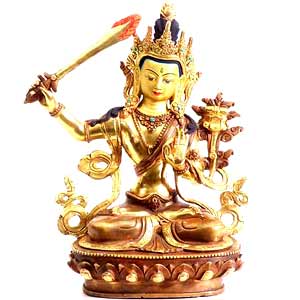
Germany
Manjushri
We often see Yama or appear in thangka with your spouse, Chamundi, is dedicated to Yama first cup of pharmaceuticals blood demon (nectar). And the dead bodies as is of Yama jewelry. Yama's dark blue buffalo.
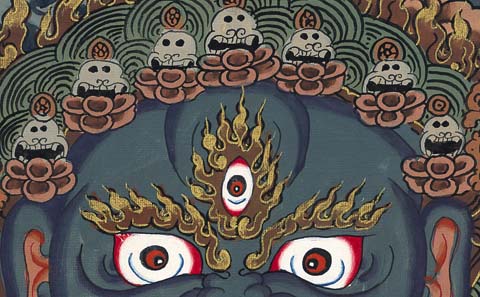
Yama's
crown
Mahakala: The Black God
The legendary history of Mahakala is written by Khedrup Khyungpopa, is the founder of the Kagyu lineage Shangpa, in the 11th century. He taught that special power and magical power of Mahakala is due chapel force of Avalokiteshvara (Guan Yin). He vows and samsara and decided not to become Buddha if not enlightened beings. After helping hundreds of thousands of people, in countless lives to reach enlightenment. He found that the pain does not decrease that much more pollution in the mind being on a growth. He was disappointed, discouraged. At that instant his head and broke into a hundred thousand pieces. Buddha Amida (Amitabha) a 5 Buddha (Lo Na price Buddha, Buddha maternity, Khai Vanity United Buddha, Amitabha Buddha, Meditation Lei Yin Buddha-nd) put the broken pieces back, and turned into the first 11. He then instructed Avalokiteshvara do the prayer again, but keep that vow better, more secure. Therefore Avalokiteshvara with eleven, and in the top ten which is gentle and is indignant. Early indignation that is representative of Mahakala.
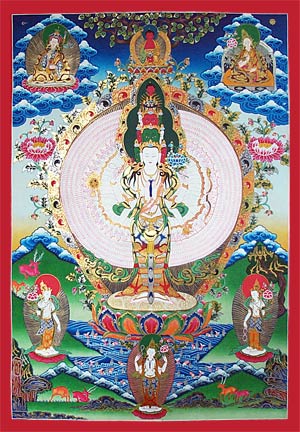
He Avalokiteshvara
He Avalokiteshvara sadly, over a period of 7 days. He thinks that the world is full of suffering beings need real results quickly without too much effort. Then he wants to turn himself into a wrathful deity to beat rapidly and more effective obstacles to the happiness of others. With this thought the letter HUM dark green appearance from his heart. Syllable Hum has become Mahakala. That means that in the mantra 'Om Mani Padme Hum', syllable Hum symbolizes strength, power.
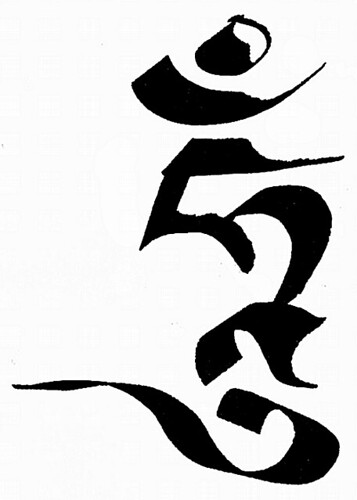
Tibetan syllable Hum
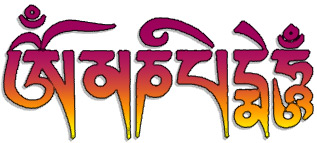
The mantra Om Mani Padme
Hum
The appearance of Mahakala involves the vibration of the ground, and the voice of the buddhas resounded in the air proved that Mahakala enough power to avoid giving what to look forward to if the desire is honest and good. Mahakala is a household spirit guardian for the Mongol ruler Genghis Khan-at that time. Wrath of Mahakala is considered as the wrathful incarnation of Siva. In Tibet, the image of Mahakala is usually a head and three eyes, eyebrows like small flames and beard, looks like a hook. Mahakala from 2 to 6 hands. fundamental nature that Tibetans often worship Mahakala is probably because he is the god of tents. Because nomadic Tibetans live so long time in the blood is dependent on nature and the environment, so they use tents, temporary migration and settlement is an important part of the their lives. addition he is a protector is very important, therefore in each monastery is a place of worship Mahakala.
Yamantaka (Easter Da
Ma)
Yamantaka is a wrathful incarnation of Manjushri (the Bodhisattva of wisdom), Yamantaka is personified complex and the most terrible wrath of all the wrathful incarnation of Buddhism. In this incarnation, Manjushri has conquered death Yama, when Yama is in raging bloodthirsty revenge killing Tibetans. According to legend, in the university, Manjushri throughout all where in the hell to Yama search. Finally he found the abode of Yama and his subordinates that iron is a city in hell. (Yama at this time in the form of body water buffaloes). To subdue Yama, Manjushri use such shapes, but in addition to eight first and multiplied hand, each arm holding breast Gas scary. And more from yourself, he grew a corresponding number of pins, around him a large number of living beings are terrified. To deal with death, he was the embodiment of death itself is multiplied many times. The god of death Yama see myself but the horror many many times. Now the god of death Yama encounter the true situation is "scared to death." That is why the yogi practice of Yamantaka, through object fine Yamantaka they will be strong enough to face with death, as well as the fear of death. Each head, each arm, feet until each attitude, each piece of jewelry, all symbols of Yamantaka are necessary to bring enlightenment to the face of death.
Both Yama and Yamantaka take the buffalo Minister is the head of but Yama is always a jewelry chest on wheels, this is a sign characteristic to distinguish the two guardians.
Kubera (Vaisravana) (Tai Bao Thien
Vuong)

According to Hindu mythology Kubera is the son of a house gentle philosophy called "Visravas", so he was named his father is "Vairavana". Legend has it that due to the serious practice, the rustic, their true for thousands of years. Brahma (Brahma), a form created in Hindu mythology, gave him immortality and made him god of the wealth. He was the god of protection for all the treasures of the earth. He will play this treasure to those who deserve it. abode of Kubera is the Kailash mountain (a sacred mountain, the people of Tibet are or pilgrimage to, Legend anybody to be this sacred mountain seems to have a lot of karma purification, as well as go a long path - the translator). But when Brahma appointed Shen Bao, Brahma gave him the Lanka (Ceylon) his capital. Also according to legend, Brahma also gave the car pushpaka, a huge car and moving in the opinion of the owner with a terrible speed Kubera is also worshiped by the Buddhists He was seen as a protector of the North (in some documents said Kubera is Sa Mon Uranus, defend in the north, all natural make-nd). featured icon he is the fox. This particular fox always treasure released.

According to Buddhism, he is also known as Jambhala. He always appeared below form to fat and covered with jewels. His right leg is always stepping on a snail shell on a lotus (shell represents his tremendous speed).
Hayagriva: Code First Minh Vuong
Intelligent prefix kingdom of
wrath
Tibetan Hayagriva was worshiped in a major way by horse dealers because it is believed that Hayagriva threatened and chased the devil away by horse theater rang sky. When people appeal, he will signal the coming of his theater language, which is why the horse head mark, a characteristic sign of Hayagriva. sounds rang out from the horse, according to the legend is able to penetrate the screen of ignorance and bring the true light of freedom. His mantra contains the following verse. "May he protect horses Increasing the number of horses from horses will be born more divine horse Would you please clear all the obstacles on the way and guide us in the right direction " (due to the nomadic lifestyle of the Tibetans, so the horse is an important thing can not be missing in their daily activities-nd) Hayagriva is a wrathful incarnation of Avalokiteshvara (Avalokitesvara), according to the study, there were 108 forms of Hayagriva. His special ability is healing, especially diseases of the skin, even quite serious skin diseases such as leprosy. This disease is believed caused by Naga (Naga dragons but solid form like, would love to live in the rivers, lakes, ocean ... nd) The simplest Minister of him there one face, two arms and two legs. Everything about him is scary faces with three eyes, mouth roaring roar full of fangs, standing posture of a warrior, the huge belly that does not contain an internal power wasted in it. His right hand region to threaten the enemy sword, left hand raised in a scary pose auxiliary, his jewelry is the snake.

Hayagriva with the simple
form
His beauty is the scary things mentioned above, because the scary aspect that is an expression of compassion, the very scary that helps us let go of the ego, and penetrate the screen ignorance ....
Palden Lhamo:
Goddess
Palden Lhamo is the only female guardian of the group of eight great protector of Buddhism. He is a Dharma protector protection for women everywhere, including the Dalai Lama and Tibet, Lhasa. At the same time he is also the guardian female country China since the Yuan Dynasty (Raw - 13th century) until the end of the Qing Dynasty (Qing) the beginning of the 20th century. In India, Palden Lhamo also known as Shri Devi. He is the goddess Okkin Tungri in northern Mongolia. He is also regarded as an incarnation of Saraswati wrath (Popular in God-nd) goddess of learning, of eloquence (to speak), and the music. Another incarnation of him as Chamudi, spouse of Yama. Theory also said his is Mahakala partner. female is the only way to protect Dharma, so legend that his weapon which is been granted by the other gods. Hevajra gave his two particles dice to determine the lives of human beings, Brahma offered him a fan made of peacock feathers, from Vishnu he was awarded two bright lights (like two jewels shining halo-nd) . A, which he installed on top of the head, the rest he put in at the waist. Kubera, Shen Bao, gave him a lion (the lion jewelry-nd) and that he wore in his right ear. Nanda, snake gods, gave him a snake (the snake jewelry-nd) and are worn on his left ear. Vajrapani (Kim Cang Player) he received a thunder hammer. The gods give him a mule, surrounded by the devil deleted, and the snake wrapped around the abdomen. People or that he rode this mule traveled across all methods.
Statues of Palden
Lhamo
There is also a legend that says more about his compassion. Legend has it that he is engaged to a king named Shenji, who is both a bloodthirsty king is a brutal fighter, he refused all requests of Palden Lhamo pray he stops killing people innocent. Finally, he had given an ultimatum: If you do not stop murder, she will kill her children with the king, so that he can experience the pain of their relatives killed that he caused for others. Shenji they did not stop, so he made his threat. Before the death of his son, he was forced to stop. Him or seen carrying the body of his son on the back of mules everywhere. This is a symbol of determination did not stop before anything to bring peace to all.
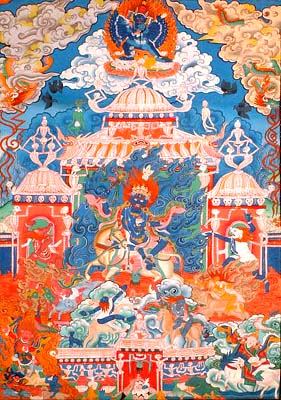
Tshangs Pa (Brahma
White)
Brahma (Brahma), is a most important deity for Hindus, but for Buddhists, Brahma represent a secondary position. Tibetan name of Brahma is Tshangs Pa, we often know Brahma with four image two hands. But in Tibetan Buddhism, he is always shown with white, 1 head 2 arms and called "Tshangs pa po dkar". Means Tshangs White Pa.

Brahma in Hindu
iconography
As well as sadhana, this is an image of Brahma. People often see him sitting on a white horse, sword raised high, sometimes wearing the flag behind him. He is a god of warriors, but not too horrible and barbaric embodiment. Behind his crown is thin towel containing the shells (one of the common auspicious symbols of Tibetan-nd) . He wore long-sleeved clothing and "floating like clouds." Although the legend behind his origin does not contract with Brahma, but we have an interesting legend: Once upon a time when he was born, and named Tshangpa Karpo. He grew up with all the powerful, he used to walk everywhere in the universe on the back a day vang.Vao horse, he roamed the sky, to night, the new landing. One day, he went to heaven. Then he cheated is a goddess (goddess-nd) named Dhersang, and steal the jewel of the gods. Bad luck, he did not escape in time because of a protective deity of heaven using his tongue to grab him and throw him back to the ground, take back the jewel from his hand, also and take heart always ngai.Hon more he was forced to promise to marry goddess Dhersang.

Tsangpa
Disappointed by his defeat,
he continued his journey in the universe. He started killing all the young people in the
places he went through, and forced the girl that he met. One day he met the goddess
Ekajati. With
the intent to harass the goddess, he began to let his bees butterflies.
Goddess
Ekajati angry and use their silk scarves are wrapped on to beat
him.

Ekajati - terrible
mother
Was hit on the thigh, his leg broken away to leave. The evaluation of the goddess immediately makes his enlightenment and became one of the guardians of Buddhism. The rating does not mean that the physical assault on one aspect. It is the attack on the negative, the dark aspects of the mind and transform it. Because power, his infinite capacity to be redirected to the protection offered for the truth, has led him to become one of the great protector of Buddhism. Historically, this is also the image represents the integration of the ancient religion of Tibet (Bon) on Buddhism by the great guru Padmasambhava (Padmasambhava).
Begtse: God of
War

The barbarian warrior, which is deleted, is the god of war in Central Asia, armor and costumes of the Mongols, appear in Tibetan Buddhism in the second half of the 16th century, is the last guardian joined the group 8 guardians.
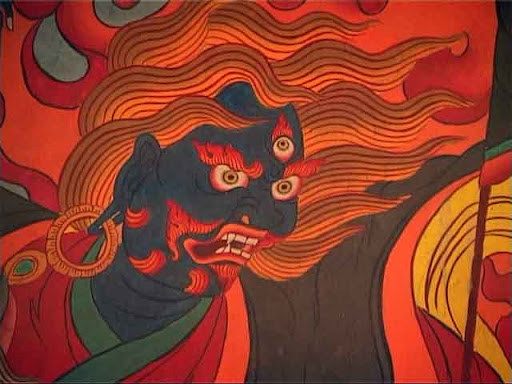
Yaksha -
Deleted
According to legend, Begtse, the leader of an army of animals, occurs when the Dalai Lama, was invited to Tibet to Mongolia by King of Mongolia at that time was Atlan Khan (Genghis Khan's descendants- nd) conversion to Buddhism the state religion of the Mongols. Knowing this ought Dalai Lama of the Guan Yin Four Player Avalokiteshvara, the bodhisattva of compassion, his arms folded over his chest forming press voluntary requirements. Footsteps of the horse he rode, in the sand is not that strangely footprint is the mantra Om Mani Padme Hum.Tan witness this miracle, consecutive Begtse trust right to primacy, the excess superiority of Buddhism and automatic submission, and converted to Buddhism. It said submission of Begtse the image for the transformation of the state religion of Mongolian Buddhism.

Portrait of
Begtse
His first appearance with full costumes as other households, holding up a sword (sword staff scorpions) in the right hand. The left hand is holding an orange enemy's head, we can see his bow name at the same time. He stepped on the dead man's left leg, foot rest, he stepped on a dead horse. His three eyes full of anger, glaring enough to threaten Dharma vandals.
*
Sometimes his confession: Thien Duyen finally completed articles Noble
Foundation protector. It's a phenomenon of stress caused Thien Duyen, is to contribute a
little effort makes its most Buddhist practitioners and practitioners of
Vajrayana know more about the guardians. Also see this as an offerings of Thien Duyen and
fellow denTam Bao, lineage, the patriarchs, to the Buddha HH18th Dromtug
Rinpoche Losang Choekye Pelden and my root guru HH Gyalwang Drukpa XII ...
END=VIETNAMESE TRANSLATE ENGLISH BY BIKKHUNI GESHE TASHI TSERING.VIETNAMESE TIBET BUDDHIST NUNS=GOLDEN LOTUS TIBET MONASTERY=AUSTRALIA,SYDNEY.26/10/2012.MY HOMELAND=VIETNAM,NHA-TRANG=KHANH-HOA.OM MANI PADME HUM.( 3 TIMES ).
No comments:
Post a Comment